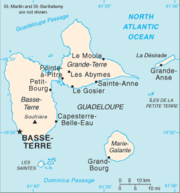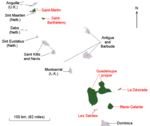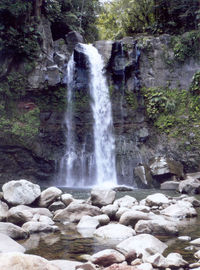Guadeloupe
2007 Schools Wikipedia Selection. Related subjects: Central & South American Countries; Countries
Guadeloupe is an archipelago located in the eastern Caribbean Sea at {`{coor dm|16|15|N|61|35|W|type:country}}, with a total area of 1,780 square kilometres (687 sq. mi). It is an overseas département ( département d'outre-mer, DOM) of France. As with the other DOMs, Guadeloupe is also one of the twenty-six régions of France (being a région d'outre-mer) and an integral part of the Republic. As part of France, Guadeloupe is part of the European Union; hence its currency is the euro. Guadeloupe is however not party to the Schengen Agreement.
History
Guadeloupe was populated from 300 BC by the Arawak Amerindians, who fished and developed agriculture on the island. It was next inhabited by the Caribs, who pushed out most of the Arawak in the 8th century, and who renamed the island "Karukera" or the "Island of beautiful waters".
During his second trip to America Christopher Columbus became the first European to land on Guadeloupe on 14 November 1493. He called it Santa María de Guadalupe de Extremadura, after the image of the Virgin Mary venerated at the Spanish monastery of Villuercas, in Guadalupe, Extremadura.
The French took possession of the island in 1635 and wiped out many of the Carib amerindians. It was annexed to the kingdom of France in 1674. Over the next century, the island was seized several times by the British. One indication of Guadeloupe's prosperity at this time is that in the Treaty of Paris ( 1763), France, defeated in war, accepted to abandon its territorial claims in Canada in return for British recognition of French control of Guadeloupe.
In an effort to take advantage of the chaos ensuing from the French Revolution, Britain attempted to seize Guadeloupe in 1794 and held it from April 21 to June 2. The French retook the island under the command of Victor Hugues, who succeeded in freeing the slaves. They revolted and turned on the slave-owners who controlled the sugar plantations, but when American interests were threatened, Napoleon sent a force to suppress the rebels and reinstitute slavery. Louis Delgrès and a group of revolutionary soldiers killed themselves on the slopes of the Matouba volcano when it became obvious that the invading troops would take control of the island. The occupation force killed approximately 10,000 Guadeloupeans in the process of restoring order to the island.
On February 4, 1810 the British once again seized the island and held it until March 3, 1813, when it was ceded to Sweden as a consequence of the Napoleonic Wars. Sweden already had a colony in the area, but merely a year later Sweden left the island to France in the Treaty of Paris of 1814. An ensuing settlement between Sweden and the British gave rise to the Guadeloupe Fund. French control of Guadeloupe was finally acknowledged in the Treaty of Vienna in 1815. Slavery was abolished on the island in 1848 at the initiative of Victor Schoelcher. Today the population of Guadeloupe is mostly of African origin with an important European and Indian active population. Lebanese, Chinese, and people of many other origins are also present.
Geography
Guadeloupe comprises five islands: Basse-Terre, Grande-Terre (separated from Basse-Terre by a narrow sea channel called salt river) with the adjacent islands of La Désirade, Les Saintes and Marie-Galante.
Basse-Terre has a rough volcanic relief, while Grande-Terre features rolling hills and flat plains.
Further to the north, Saint-Barthélemy and the French part of Saint Martin come under the jurisdiction of Guadeloupe.
On December 7, 2003, both of these areas voted to become an overseas territorial collectivity.
Demographics
(July 2006 estimates)
| Population | 452,776 | ||
| Age structure | 0 to 14 years | 23.6% | male 54,725 female 52,348 |
| 15 to 64 years | 67.1% | male 150,934 female 153,094 |
|
| 65 years and older | 9.2% | male 17,353 female 24,322 |
|
| Population growth rate | 0.88% | ||
| Birth rate | 15.05 births | per 1,000 people | |
| Death rate | 6.09 deaths | ||
| Net migration rate | -0.15 migrants | ||
| Sex ratio (male:female) |
at birth | 1.05 | |
| under 15 years | |||
| 15 to 64 years | 0.99 | ||
| 65 years and older | 0.71 | ||
| Overall | 0.97 | ||
| Infant mortality rate | 8.41 deaths per 1,000 live births | ||
| Life expectancy at birth |
males | 74.91 years | |
| females | 81.37 years | ||
| Overall | 78.06 years | ||
| Total fertility rate | 1.9 children born per woman | ||
| Demonym | Guadeloupean(s) (not Guadeloupians) | ||
| Adjectival | Guadeloupe, Guadeloupean | ||
| Ethnic groups | Black / Mulatto | 75% | |
| White | 11% | ||
| Tamil / East Indian | 9% | ||
| Lebanese / Syrians | 3% | ||
| Chinese / others | 2% | ||
| Religion | Roman Catholic | 91% | |
| Protestant | 5% | ||
| Hindu / African | 4% | ||
| Language | French (official) 99%, Creole patois | ||
| Literacy | males | 90% | |
| females | |||
| Overall | |||
Administrative divisions
Administratively, Guadeloupe is divided into arrondissements, cantons and communes:
- Arrondissements of the Guadeloupe département
- Cantons of the Guadeloupe département
- Communes of the Guadeloupe département
Politics
| National holiday | Bastille Day, 14 July (1789) | ||||
|---|---|---|---|---|---|
| Slavery Abolition Day | 27 May (1848) | ||||
| Constitution | 28 September (1958) | ||||
| Legal system | French | ||||
| Suffrage | Universal at 18 years old | ||||
| Executive branch | Chief of state | President Jacques Chirac represented by Prefect Paul Girot de Langlade |
since 17 May 1995 since 7 July 2004 |
||
| Head of government | President of the General Council Jacques Gillot President of the Regional Council Victorin Lurel |
since 26 March 2001 since 22 April 2004 |
|||
| Cabinet | n/a | ||||
| Elections | French president elected by popular vote for five-year term; Prefect appointed by the French president on advice of the French Ministry of the Interior; General and Regional Council presidents elected by membership of those councils. |
||||
| Election results | n/a | ||||
| Legislative branch | Unicameral General Council (Conseil General; 42 seats) Unicameral Regional Council (Conseil Regional; 41 seats) |
members elected by popular vote to serve six-year terms |
|||
| Elections | General Council
|
||||
| Election results | General Council
|
||||
| Judicial branch | Court of Appeal (Cour d'Appel) in Basse-Terre; Assize Court (Cour d'assises) in Basse-Terre to try felonies, consisting of three judges and a popular jury; Several first instance courts of varying competence levels, in Basse-Terre, Pointe-à-Pitre, Saint-Martin and Grand-Bourg. |
||||
| Political parties | Guadeloupe Communist Party (PCG) · FGPS · Progressive Democratic Party (PPDG) · Union for a Popular Movement (UMP) (formerly the Rassemblement pour la Republique, RPR) · Socialist Party (PS) · Union for French Democracy (UDF) | ||||
| Pressure groups | Union for the Liberation of Guadeloupe (ULPG) · General Federation of Guadeloupe Workers (CGT-G) · General Union of Guadeloupe Workers (UGTG) · Movement for Independent Guadeloupe (MPGI) · The Socialist Party | ||||
| International membership |
FZ · WCL · WFTU | ||||
Culture
Guadeloupe's culture is probably best known for the islanders' literary achievements, particularly the poetry of Saint-John Perse, the pseudonym used by Alexis Léger. Perse won the 1960 Nobel Prize in Literature "for the soaring flight and the evocative imagery of his poetry which in a visionary fashion reflects the conditions of our time."
Guadeloupe has always had a rich literary production prolonged today by many living writers, poets, novelists, essayists and journalists, among them Maryse Condé, Ernest Pépin and Simone Schwartz-Bart.
Also culturally important are the arts, particularly painting and sculpture. Famous painters and/or sculptors include Michel Rovelas, Claudie Cancellier, Jean-Claude Echard, Christian Bracy, Roger Arekian, les Frères Baptiste, Michelle Chomereau-Lamothe, Léogane, Pédurand, Nicole Réache, Victor Sainsily. Photographer and visual effects artist Karim Sahai of Weta Digital, New-Zealand, has worked on the visual effects of The Lord of the Rings, King Kong, X-Men, etc.
Music and dance are also very popular, and the widely accepted interaction of African, French and Indian cultures has given birth to some original new forms specific to the archipelago. Islanders enjoy many local dance styles including the quadrille "au commandement", zouk, zouk-love, toumbélé, as well as all the modern international dances. Typical Guadeloupean music includes la biguine and gwo ka à la base. Many international festivals take place in Guadeloupe, like the Creole Blues Festival, the Marie-Galante Festival, Festival Gwo-Ka Cotellon, etc. It goes without saying that all the Euro-French forms of art are also omnipresent in the melting pot.
Another element of the Guadeloupean culture is its dress. Women in particular have a unique style of traditional dresses, with many layers of colorful fabrics, now only worn on special occasions. On festive occasions they also wore a madras (originally the 'kerchief' from South India) head scarf tied in many different symbolic forms. The headdress could be done in many styles with names like the "bat" style, or the "firefighter" style, as well as the "Guadeloupean woman." Jewelry is also important, mainly of gold, in the Guadeloupean lady's dress, a product of European, African and Indian inspiration. Many famous couturiers like Devaed or Mondelo are Guadeloupeans.
Economy
The economy of Guadeloupe depends on tourism, agriculture, light industry and services. It also depends on France for large subsidies and imports.
Tourism is a key industry, with 83.3% of tourists visiting from continental France, 10.8% coming from the rest of Europe, 3.4% coming from the United States, 1.5% coming from Canada, 0.4% coming from South America and 0.6% coming from the rest of the world . An increasingly large number of cruise ships visit the islands.
The traditional sugarcane crop is slowly being replaced by other crops, such as bananas (which now supply about 50% of export earnings), eggplant, guinnep, noni, sapotilla, paroka, pikinga, giraumon squash, yam, gourd, plantain, christophine, monbin, prunecafé, cocoa, jackfruit, pomegranate, and many varieties of flowers. Other vegetables and root crops are cultivated for local consumption, although Guadeloupe is still dependent on imported food, mainly from France.
Light industry features sugar and rum, solar energy, and many industrial productions. Most manufactured goods and fuel are imported. Unemployment is especially high among the youth. Hurricanes periodically devastate the economy.
The country code top-level domain (ccTLD) for Guadeloupe is " .gp".







